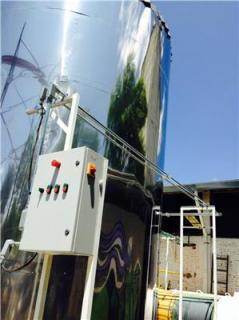Mar 19 2015
The Center for Research and Technological Development in Electrochemistry (CIDETEQ), in Mexico, has managed to obtain biogas from "garbage or organic waste", having replaced part of the natural gas used by the Pilgrim's company in the state of Querétaro, which produces chicken, and in Xaquixe, a company dedicated to the development of glass art in the state of Oaxaca.

Since 2008, the center began a research project with support form the Program of Incentives for Innovation of the National Council of Science and Technology (Conacyt) to use waste, fats, processed residue and water with high loads of the Pilgrim’s company to generate biogas .
The engineer Arnulfo Terán Lopez, head of the group of alternative energies at CIDETEQ explains that when research began at Pilgrim's they collaborated with specialists from the University of Brandenburg, Germany.
For this work, the center evaluated the potential of water with high loads. They benefited form the fat and the remainders of processed chicken to generate biogas at a pilot level. The project aimed to purify biogas, compress and conduct it for use in boilers that generate steam. Researchers found that it was possible to replace all the natural gas consumed in the company with biogas.
"With the project in Querétaro, the company Xaquixe of Oaxaca realized it was feasible. They visited us and the relationship between academia and the enterprise has being going for three years," says the Mexican researcher.
The first stage consisted of research to determine whether the project was viable, the second phase was the construction of the pilot plant and currently researchers will scale the technology to an industrial level in the field of recycled glass, which can be extended to processing handmade pottery in Oaxaca.
For the generation of biogas, the company Xaquixe utilized solid waste, cow dung and pig manure, because according to the specialist they obtain better performance combining substances for the production of biogas.
"The process can be assembled at an industrial scale process and become economically self-sustaining. As such mixtures allow more efficient biogas production because they contain the adequate nutrients," says López Terán.
The researcher adds that once the substrate is determined and appropriate testing performed, the potential to produce biogas is determined. The next step is to produce in the reactor in order to characterize the obtained gas, because biogas is a mixture of methane, carbon dioxide, nitrogen, water vapor and traces of other compounds such as hydrogen sulfide, which may cause equipment damage when used as fuel.
"Biogas as such, can not be applied directly. We have to condition it, store it and conduct it for use; using independent techniques to the bioreactor, such as apumping and washing system, but this will depend on the final application for the compound," points the specialist at CIDETEQ.
Particularly for glass melting processes, used by Xaquixe, besides the generation and use of biogas, CIDETQ developed solar concentrators to provide thermal energy to the bioreactor. The thermal energy, which is captured with hubs, it’s used as a part of this pumping system, resulting in saving energy consumption and greater overall output efficiency.
The center is also looking to transfer the technology to the mezcal (liquor similar to tequila) industry where large amounts of energy are used, using biogas and solar thermal energy in some parts of the process, for example, distilling mezcal without firewood.